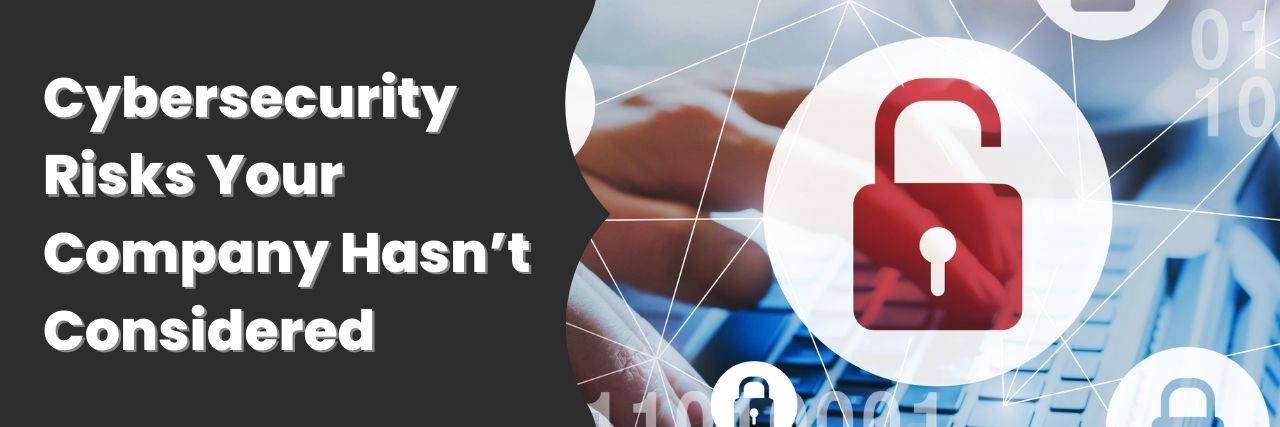The Top 4 Cybersecurity Risks Your Company Hasn’t Considered
May 3rd, 2022 | 5 min. read

If you think your business is safe from all the risks of cybersecurity, think again.
There’s no getting around the prevalence of cybercrime today; it’s happening more and more all across the globe. Even worse? The cybercriminals lurking behind the scenes are getting better at exploiting weaknesses to get their hands on confidential business data.
In 2021, RiskIQ reported a whopping $1,797,945 per minute loss in organizations due to an average cybersecurity incident. As a result, business owners are often scrambling to ensure they’re doing enough to keep security tight. Perhaps they invest in some total solution software or overload a tech-savvy team member with IT security work. Some business owners (fingers crossed it’s not you) simply decide to roll the dice and hope for the best.

Whether it’s doing too much or too little, business professionals often get caught up in a less-than-ideal approach to cybersecurity.
So, what should you do with all the horror stories in the headlines about companies and government agencies getting breached? Well, the key is to remain focused and strategic so you can put together a level-headed plan. This involves taking a closer look at some of those huge cyber threats we often forget about.
As a Managed IT Service Provider (MSP) for nearly twenty years, ITS has helped over a hundred businesses reinforce robust cybersecurity; the first step is to be aware of the risks.
This article will give you a list of the top four cybersecurity risks your company probably hasn’t considered before and how you can fix them to prevent damage.
4 Cybersecurity Risks and How to Fix Them
In order to develop a realistic and strategic approach to cybersecurity, you have to cut out all the noise. Put the headlines and your fears to the side and stay focused on the things you and your team can control. Think long and hard about the various ways cyberattacks could occur in your organization, and then consider how you can work to close the gaps in each section.
Check out this list of security risks that your organization must be carefully managing:
1. Human error
 No one likes to admit that internal risks exist, but the reality is that employees are the weakest link in the cybersecurity chain.
No one likes to admit that internal risks exist, but the reality is that employees are the weakest link in the cybersecurity chain.
Sometimes these internal threats are malicious, but most often, it’s a matter of ignorance and carelessness. In fact, human error accounts for 90% of cyber-attacks on businesses.
The reality is, that an uninformed and unprepared team can have drastic consequences for your organization’s cybersecurity. Some incidents that you may encounter are:
- An individual clicking on a malicious email link,
- Downloading a bad file from a phishing scam, or
- Receiving and opening a fraudulent business email compromise (BEC) scam.
These are just a few of the human errors that can put your organization at serious risk.
How to raise your team’s cybersecurity awareness:
The best way to counteract employees who aren’t in the know is to teach them. Yes, this will require some investment of time and resources, but your organization will be stronger and more secure in the long run.
Find ways to get your team on board and help empower them to be cybersecurity superheroes. Walk them through identifying threats and create an environment for open and honest communication about suspicious activity of any kind. Your cybersecurity woes will be reduced significantly with an informed and vigilant team.
Another possible cybersecurity risk that involves a human being is password malpractice.
Passwords are supposed to keep your organizational data safe and secure. But here are some questions for you: when’s the last time your team changed their passwords? Is there a culture of password-sharing or posting in your office that threatens security? For that matter, have you and your team ever had an open conversation about choosing strong passwords?
No? So, what do you do next?
Like with any other part of your business, the best practice for password management is to have standard operating procedures in place to ensure your team knows what is expected. Follow these steps to help guide your team:
- Make it a rule that passwords must be kept private and changed on a 30 or 60-day basis. Mark calendars with password change dates and makes it a group activity.
- Make it a rule that passwords must be unique and not a repeat of old passwords or other accounts.
- Ensure there is a chain of command for access and control. Superiors should never share login credentials with lower-profile individuals–no matter how convenient.
- Finally, consider setting up multi-factor authentication at all endpoints to add an extra layer of verification security.
2. Patch procrastination
 In an increasingly digital workforce, hardware and software updates seem to pop up daily. However, probably due to overexposure to these update notifications, it is becoming blatantly rampant that business professionals avoid or put it off.
In an increasingly digital workforce, hardware and software updates seem to pop up daily. However, probably due to overexposure to these update notifications, it is becoming blatantly rampant that business professionals avoid or put it off.
Sometimes, there is also this fear of change or increased technical issues once an update is installed–and this can happen. However, for the most part, updates are designed correctly and will work wonders by patching unseen security flaws. This can make a huge difference in keeping your network secure.
How to stop patch procrastination:
Again, schedule your updates and mark them on calendars as much as possible. Taking the time to make a physical note will help emphasize the importance of staying on top of patchwork.
Most importantly, when your machine gives you a reminder to install an update–install it. No questions asked. Get out of the habit of clicking “Remind Me Later.” It’s not just about security either. Staying on top of updates and patches will help your systems run at optimal capacity at all times.
3. Third-party risk
 This is perhaps the biggest risk that business professionals often forget. It’s not just your own cybersecurity practices you should be worried about; it’s the other companies you work with. Vendors, business partners, consultants, basically any organization that your company deals with can impact the safety of your business data.
This is perhaps the biggest risk that business professionals often forget. It’s not just your own cybersecurity practices you should be worried about; it’s the other companies you work with. Vendors, business partners, consultants, basically any organization that your company deals with can impact the safety of your business data.
Even if you have the strongest internal cybersecurity plan in place, if a third-party vendor has less than perfect cyber security practices, attacks could find a way to access your network.
How to counteract the poor cybersecurity practices of others:
First, its critical to make your own standards clear to the partners you’re working with. While you can’t force them to get smarter about their own security, letting them know that you take cybersecurity seriously right off the bat is a great way to be transparent and encourage their vigilance.
Second, there are technical tools available to help mitigate the risks involved with external vendors. Network segmentation or divided servers can help ensure vendors only access the necessary parts of your network and nothing else. This can be a great safeguard that will help mitigate the risk of vendor weak spots.
4. Bring Your Own Device (BYOD) chaos
 It’s no secret that pretty much everyone has a computer in their pocket or purse these days. Between smartphones, tablets, and laptops, taking your favorite machine on the go is now easier than ever.
It’s no secret that pretty much everyone has a computer in their pocket or purse these days. Between smartphones, tablets, and laptops, taking your favorite machine on the go is now easier than ever.
Understandably, this has translated to the workplace with the Bring Your Own Device (BYOD) craze. BYOD can be a convenient, cost-effective, and morale-boosting practice for small businesses.
However, there is a downside to letting endless personal devices through the doors and onto your business network. In fact, the security risks involved can be pretty serious. Some of the risks are:
- Data theft
- Home or public internet risks
- Improper mobile device management
- Shadow IT
- Lost or stolen devices
Personal devices likely do not have the same security standards and protocols as corporate devices do. This can leave your organization wide open and much more susceptible to hacks and data breaches.
How to balance BYOD benefits and risks:
There’s no better way to do this than get policies and procedures on paper if your organization allows staff to bring in their own devices. Here are some things you can implement:
- Make sure your employees know the risks involved and develop some detailed policies that will keep your network as secure as possible.
- Make sure personal devices can only access the corporate networks through a virtual private network (VPN).
- Ensure that all employees have multi-factor authentication set up on their accounts to maintain adequate verification.
Just like all the other areas, proactive education is crucial. An informed team will make all the difference.
Put Your Cybersecurity Risks Plan Into Action
There’s no denying that business professionals are constantly on-the-go, but making cybersecurity a top priority is a critical way to ensure your IT infrastructure is protected. Now that some of the basic groundwork has been laid, it’s time to ditch the hopelessness and procrastination. Get your plan in action.
Here at ITS, we’ve helped hundreds of clients bolster their cybersecurity. Learn about the three types of cybersecurity solutions your business must have to start putting everything you’ve learned into practice.
Jess is a Content Writer who commits herself to creating helpful, relevant, and easy-to-digest technical articles. When she isn't writing, she devotes her energy (and money) to collecting K-Pop photo cards, which she likes to call an 'investment.'
Topics:

